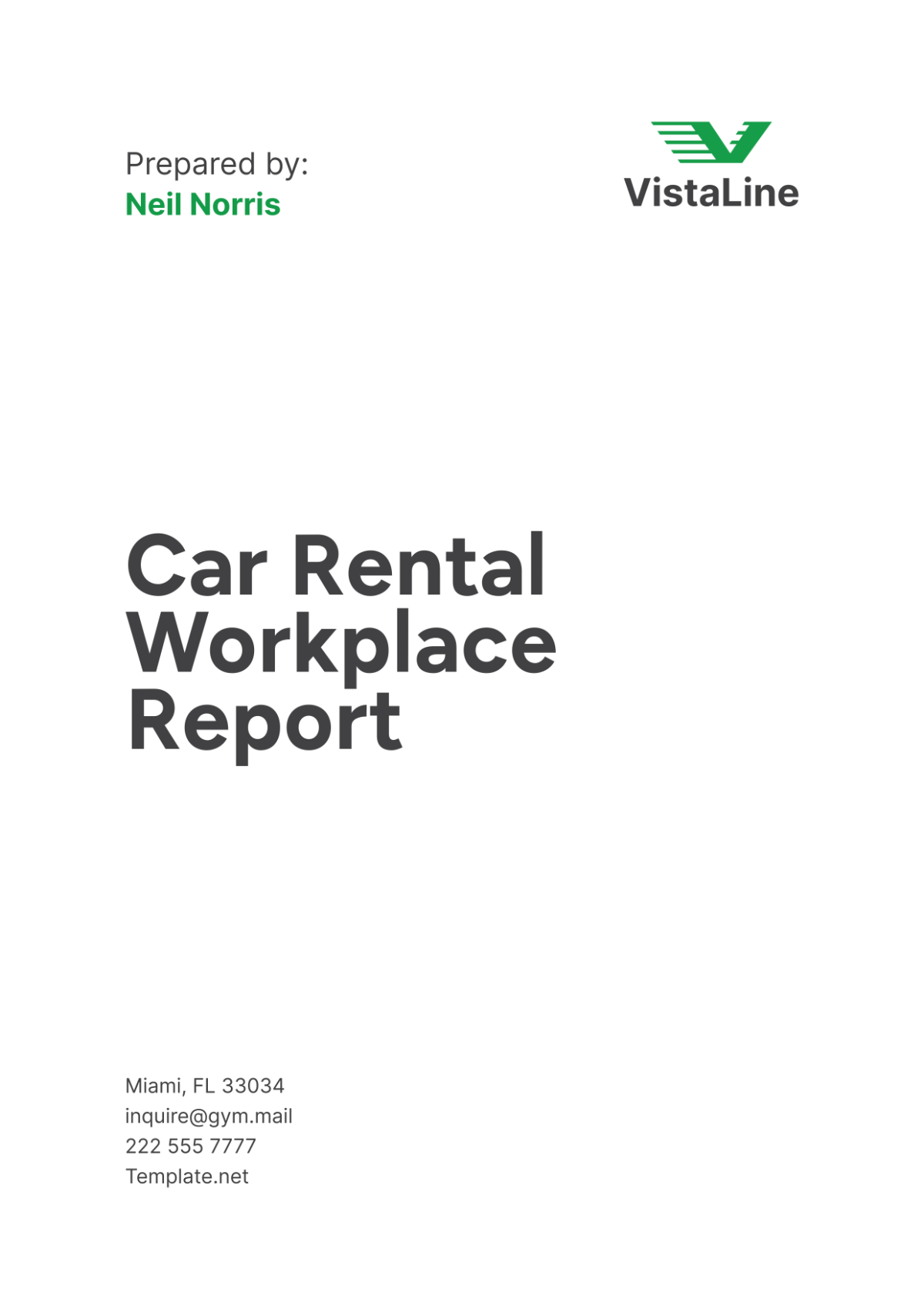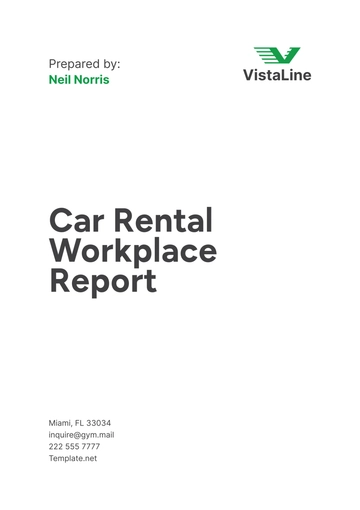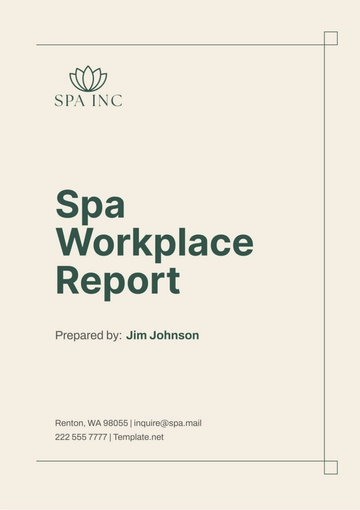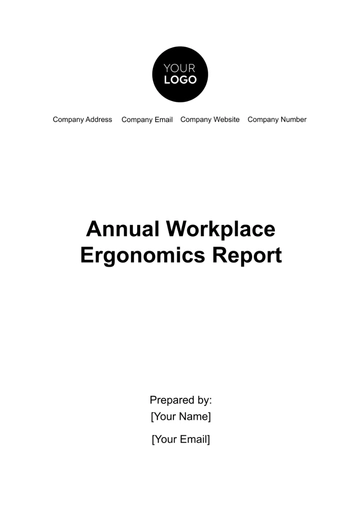Free Car Rental Workplace Report

Year Ended: December 31, 2050
Executive Summary
The Car Rental Workplace Report for [Your Company Name] provides a comprehensive overview of the operational and safety performance, employee satisfaction, and customer feedback for the year 2050. This report is intended to give stakeholders a clear understanding of the workplace environment, highlight areas of success, and identify opportunities for improvement. Our commitment to maintaining a high standard of service and a positive work environment is evident through the various initiatives and programs implemented throughout the year.
Key Highlights
Operational Efficiency: Achieved a 10% increase in fleet utilization and a 5% reduction in operational costs.
Employee Satisfaction: Employee satisfaction increased by 12%, with significant improvements in work-life balance and professional development opportunities.
Customer Feedback: Received a 90% positive feedback rating from customers, indicating high levels of satisfaction with our service.
Safety Performance: Reduced workplace incidents by 15%, demonstrating our commitment to a safe and secure working environment.
Introduction
Purpose
The purpose of this report is to provide a detailed analysis of the workplace environment at [Your Company Name]. It aims to assess the effectiveness of our operational practices, employee satisfaction, customer service, and safety performance. The insights gained from this report will help guide future improvements and strategic planning.
Scope
This report covers the following key areas:
Operational Performance
Operational performance is crucial for the overall success and sustainability of our business. This section analyzes various metrics such as fleet utilization, cost management, and the efficiency of our rental operations. By examining these metrics, we can identify areas where we excel and areas that require improvement. This analysis will help us implement strategies to enhance operational efficiency, reduce costs, and improve service delivery. Key performance indicators (KPIs) and benchmarking against industry standards will be used to provide a comprehensive assessment of our operational performance.
Employee Satisfaction
Employee satisfaction is a vital component of a thriving workplace. This section delves into the results of our annual employee satisfaction survey, focusing on job satisfaction, work-life balance, and opportunities for professional growth. By understanding the needs and concerns of our employees, we can create a more supportive and engaging work environment. This part of the report will also highlight the effectiveness of our employee engagement programs, such as flexible work arrangements, career development workshops, and wellness initiatives. Retention rates, employee feedback, and engagement scores will be analyzed to measure satisfaction levels.
Customer Feedback
Customer feedback is essential for continuously improving our services. This section summarizes feedback collected through surveys, online reviews, and direct communication. It provides insights into customer satisfaction, highlighting positive aspects of our service as well as areas needing enhancement. We will analyze patterns and trends in customer feedback to understand their expectations and experiences better. This analysis will guide us in making data-driven decisions to improve customer service, streamline processes, and enhance the overall rental experience. Metrics such as Net Promoter Score (NPS) and customer satisfaction ratings will be used to gauge our performance.
Safety Performance
Safety is a top priority at [Your Company Name]. This section provides an overview of our safety performance, including incident statistics, safety initiatives, and risk management strategies. By examining the frequency and types of incidents, we can identify potential risks and implement measures to mitigate them. The effectiveness of our safety training programs, maintenance schedules, and safety audits will be evaluated. This analysis will help us ensure a safe working environment for our employees and a secure rental experience for our customers. Incident rates, safety audit results, and compliance with safety regulations will be key metrics in this section.
Training and Development
Continuous training and development are essential for maintaining a skilled and knowledgeable workforce. This section outlines the various training programs and professional development initiatives offered to our employees. It will cover new employee orientation, ongoing training sessions, and leadership development programs. By investing in our employees' growth, we aim to enhance their skills, increase job satisfaction, and improve overall performance. Training participation rates, completion rates, and feedback from participants will be analyzed to assess the effectiveness of our training and development efforts.
Recommendations for Improvement
Based on the findings from the operational performance, employee satisfaction, customer feedback, and safety performance sections, we have identified several areas for improvement. This section provides actionable recommendations to address these areas and enhance our workplace environment. By implementing these recommendations, we aim to foster a culture of continuous improvement and excellence. Specific initiatives, timelines, and responsible parties will be detailed to ensure effective execution and monitoring of the recommended actions.
By comprehensively covering these key areas, this report aims to provide a holistic view of the workplace environment at [Your Company Name]. The detailed analysis and insights gained will be instrumental in guiding our future strategies and ensuring sustained growth and success.
1. Operational Performance
Operational performance is a critical aspect of our business, directly impacting customer satisfaction and overall profitability. This section provides an analysis of our operational efficiency, fleet utilization, and cost management.
Fleet Utilization
Fleet utilization is a key indicator of our operational efficiency. In 2050, we achieved a 10% increase in fleet utilization compared to the previous year. This improvement was driven by several factors, including:
Optimized Scheduling: Implemented advanced scheduling software to optimize vehicle allocation and reduce downtime.
Predictive Maintenance: Utilized telematics data to predict maintenance needs and minimize unexpected breakdowns.
Flexible Rental Options: Introduced flexible rental options to cater to varying customer needs, resulting in higher vehicle turnover.
Cost Management
Effective cost management is essential for maintaining profitability. In 2050, we achieved a 5% reduction in operational costs through the following initiatives:
Energy Efficiency: Upgraded to energy-efficient lighting and HVAC systems in our facilities, reducing utility expenses.
Sustainable Practices: Implemented recycling programs and reduced paper usage, cutting down on waste management costs.
Vendor Negotiations: Renegotiated contracts with suppliers to secure better pricing and terms.
Operational Challenges
Despite these successes, we faced several operational challenges:
Supply Chain Disruptions: Global supply chain issues affected the timely delivery of new vehicles and parts.
Technological Integration: Integrating new technologies with existing systems proved to be more complex and time-consuming than anticipated.
2. Employee Satisfaction
Employee satisfaction is a vital component of our workplace environment. This section details the results of our annual employee satisfaction survey, highlighting key areas of improvement and ongoing challenges.
Survey Results
In 2050, we conducted an employee satisfaction survey to gauge the overall sentiment of our workforce. The survey covered various aspects, including job satisfaction, work-life balance, and professional development.
Key Findings
Job Satisfaction: 85% of employees reported being satisfied with their jobs, an increase of 10% from the previous year.
Work-Life Balance: 78% of employees felt they had a good work-life balance, up from 65% in the previous year.
Professional Development: 70% of employees expressed satisfaction with the professional development opportunities provided, a 15% increase from the previous year.
Employee Engagement Programs
To maintain and improve employee satisfaction, we implemented several engagement programs:
Flexible Work Arrangements: Introduced flexible working hours and remote work options to enhance work-life balance.
Career Development Workshops: Offered workshops and training sessions to support career growth and skill development.
Wellness Initiatives: Launched wellness programs, including fitness classes and mental health resources, to promote overall well-being.
Challenges
Despite the positive results, we identified areas needing improvement:
Communication: Some employees felt there was a lack of clear communication from management regarding company goals and changes.
Recognition: Employees expressed a desire for more recognition and rewards for their hard work and achievements.
3. Customer Feedback
Customer feedback is crucial for understanding how well we are meeting the needs and expectations of our clients. This section summarizes the feedback received from customers throughout the year and highlights areas of success and opportunities for improvement.
Feedback Collection
We collected customer feedback through various channels, including:
Surveys: Sent post-rental surveys to gather feedback on the rental experience.
Online Reviews: Monitored reviews on platforms such as Google and Yelp.
Direct Communication: Encouraged customers to provide feedback directly through email and phone calls.
Key Findings
Positive Feedback
Overall Satisfaction: 90% of customers reported a positive rental experience, indicating high levels of satisfaction.
Customer Service: Customers praised the professionalism and helpfulness of our staff, with many noting quick and efficient service.
Vehicle Quality: Positive feedback highlighted the cleanliness and reliability of our vehicles.
Areas for Improvement
Wait Times: Some customers reported longer than expected wait times during peak periods.
Booking Process: A few customers found the online booking process confusing and suggested improvements for a more user-friendly experience.
Customer Satisfaction Initiatives
In response to the feedback, we implemented several initiatives to enhance customer satisfaction:
Streamlined Booking: Redesigned our online booking platform to make it more intuitive and user-friendly.
Staff Training: Provided additional training for staff to handle peak period demands more efficiently.
Customer Loyalty Program: Launched a loyalty program offering rewards and discounts for repeat customers.
4. Safety Performance
Safety is a top priority for [Your Company Name]. This section provides an overview of our safety performance, including incident statistics, safety initiatives, and risk management strategies.
Incident Statistics
We tracked and analyzed all safety-related incidents throughout the year. The following table summarizes the key incident statistics:
Incident Type | Number of Incidents | Change from Previous Year (%) |
|---|---|---|
Minor Accidents | 50 | -10% |
Major Accidents | 10 | -5% |
Workplace Injuries | 15 | -20% |
Customer-Reported Safety Issues | 25 | -15% |
Total Incidents | 100 | -15% |
Safety Initiatives
We implemented several safety initiatives to reduce incidents and enhance overall safety:
Driver Training Programs: Introduced advanced training modules on defensive driving and emergency response.
Vehicle Maintenance: Adopted a more rigorous maintenance schedule, resulting in fewer mechanical failures.
Safety Audits: Conducted regular safety audits to identify and mitigate potential hazards.
Risk Management
Effective risk management is essential for maintaining a safe workplace. Our risk management strategies included:
Hazard Identification: Regularly identified and assessed potential hazards through safety audits and employee feedback.
Preventive Measures: Implemented preventive measures, such as safety barriers and improved signage, to mitigate identified risks.
Emergency Preparedness: Developed and practiced emergency response plans to ensure readiness in case of an incident.
5. Training and Development
Continuous training and development are crucial for maintaining a skilled and knowledgeable workforce. This section outlines our training programs and professional development initiatives.
Training Programs
We offered a variety of training programs to enhance employee skills and knowledge:
New Employee Orientation: Comprehensive onboarding program covering company policies, safety procedures, and job-specific training.
Ongoing Training: Regular training sessions on customer service, vehicle maintenance, and safety protocols.
Leadership Development: Programs designed to develop leadership skills and prepare employees for management roles.
Professional Development
We supported professional development through various initiatives:
Tuition Reimbursement: Provided financial assistance for employees pursuing further education related to their job roles.
Mentorship Programs: Paired employees with experienced mentors to guide their career growth.
Career Pathing: Developed clear career paths and opportunities for advancement within the company.
Training Metrics
The following table summarizes the training metrics for 2050:
Training Program | Number of Participants | Completion Rate (%) |
|---|---|---|
New Employee Orientation | 150 | 100% |
Ongoing Training Sessions | 300 | 95% |
Leadership Development Program | 50 | 90% |
6. Recommendations for Improvement
Based on the findings from the operational performance, employee satisfaction, customer feedback, and safety performance sections, we have identified several areas for improvement. These recommendations aim to enhance our workplace environment and overall performance.
Operational Improvements
Supply Chain Management: Develop contingency plans to address potential supply chain disruptions and ensure timely delivery of vehicles and parts.
Technological Integration: Invest in training and support to streamline the integration of new technologies with existing systems.
Employee Engagement
Communication: Improve communication channels between management and employees to ensure clarity regarding company goals and changes.
Recognition Programs: Implement recognition programs to reward employees for their hard work and achievements, fostering a positive work environment.
Customer Service Enhancements
Reduce Wait Times: Analyze peak period demands and optimize staffing levels to reduce customer wait times.
Enhance Booking Experience: Continuously improve the online booking platform based on customer feedback to ensure a seamless and user-friendly experience.
Safety and Risk Management
Advanced Safety Training: Expand safety training programs to include more advanced modules and practical simulations.
Regular Safety Reviews: Conduct more frequent safety reviews and audits to proactively identify and address potential hazards.
Conclusion
The Car Rental Workplace Report for [Your Company Name] for the year ended December 31, 2050, highlights our commitment to maintaining a high standard of operational performance, employee satisfaction, customer service, and safety. The achievements outlined in this report demonstrate our dedication to continuous improvement and excellence in all aspects of our operations.
By implementing the recommendations for improvement, we aim to further enhance our workplace environment and overall performance. We look forward to building on the successes of 2050 and achieving even greater milestones in the coming years. For any questions or further information, please contact [Your Name] at [Your Company Email].
- 100% Customizable, free editor
- Access 1 Million+ Templates, photo’s & graphics
- Download or share as a template
- Click and replace photos, graphics, text, backgrounds
- Resize, crop, AI write & more
- Access advanced editor
Enhance workplace monitoring with Template.net's Car Rental Workplace Report Template. Ideal for documenting environmental conditions, staff performance, and operational efficiency, this template is fully editable and customizable with our AI editor tool. It provides a detailed framework to help you maintain and improve workplace standards, ensuring a safe and productive environment for your team.
You may also like
- Sales Report
- Daily Report
- Project Report
- Business Report
- Weekly Report
- Incident Report
- Annual Report
- Report Layout
- Report Design
- Progress Report
- Marketing Report
- Company Report
- Monthly Report
- Audit Report
- Status Report
- School Report
- Reports Hr
- Management Report
- Project Status Report
- Handover Report
- Health And Safety Report
- Restaurant Report
- Construction Report
- Research Report
- Evaluation Report
- Investigation Report
- Employee Report
- Advertising Report
- Weekly Status Report
- Project Management Report
- Finance Report
- Service Report
- Technical Report
- Meeting Report
- Quarterly Report
- Inspection Report
- Medical Report
- Test Report
- Summary Report
- Inventory Report
- Valuation Report
- Operations Report
- Payroll Report
- Training Report
- Job Report
- Case Report
- Performance Report
- Board Report
- Internal Audit Report
- Student Report
- Monthly Management Report
- Small Business Report
- Accident Report
- Call Center Report
- Activity Report
- IT and Software Report
- Internship Report
- Visit Report
- Product Report
- Book Report
- Property Report
- Recruitment Report
- University Report
- Event Report
- SEO Report
- Conference Report
- Narrative Report
- Nursing Home Report
- Preschool Report
- Call Report
- Customer Report
- Employee Incident Report
- Accomplishment Report
- Social Media Report
- Work From Home Report
- Security Report
- Damage Report
- Quality Report
- Internal Report
- Nurse Report
- Real Estate Report
- Hotel Report
- Equipment Report
- Credit Report
- Field Report
- Non Profit Report
- Maintenance Report
- News Report
- Survey Report
- Executive Report
- Law Firm Report
- Advertising Agency Report
- Interior Design Report
- Travel Agency Report
- Stock Report
- Salon Report
- Bug Report
- Workplace Report
- Action Report
- Investor Report
- Cleaning Services Report
- Consulting Report
- Freelancer Report
- Site Visit Report
- Trip Report
- Classroom Observation Report
- Vehicle Report
- Final Report
- Software Report



